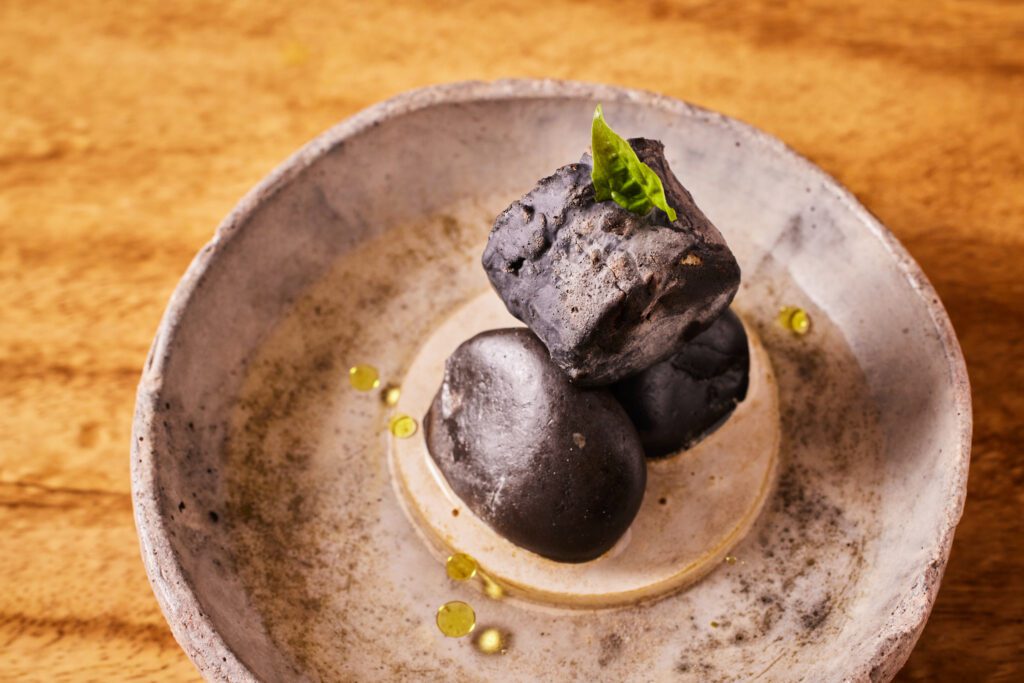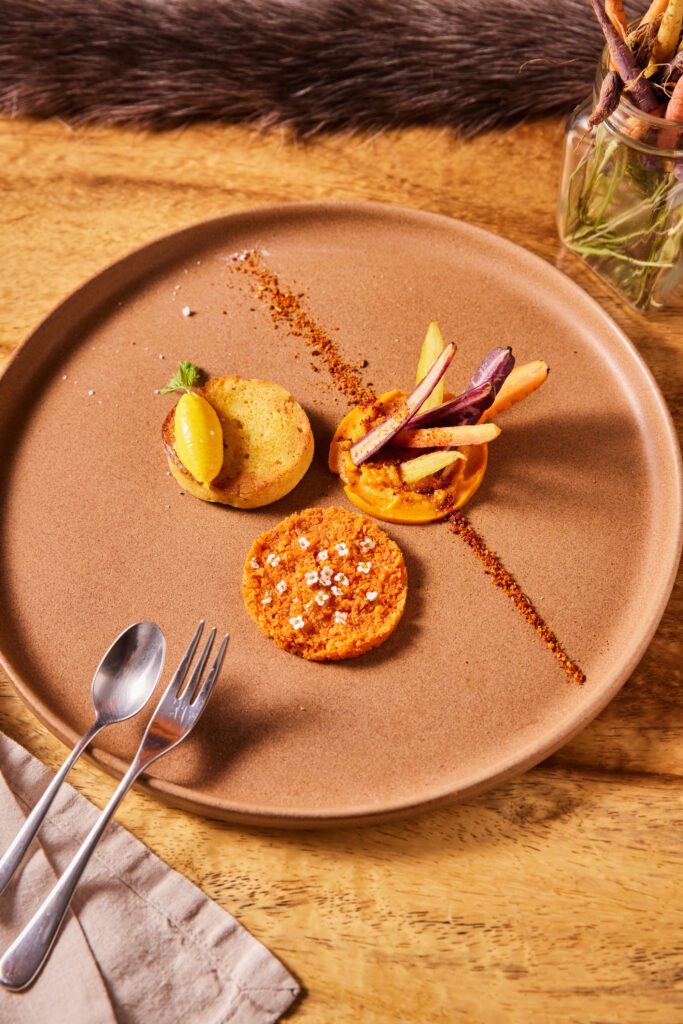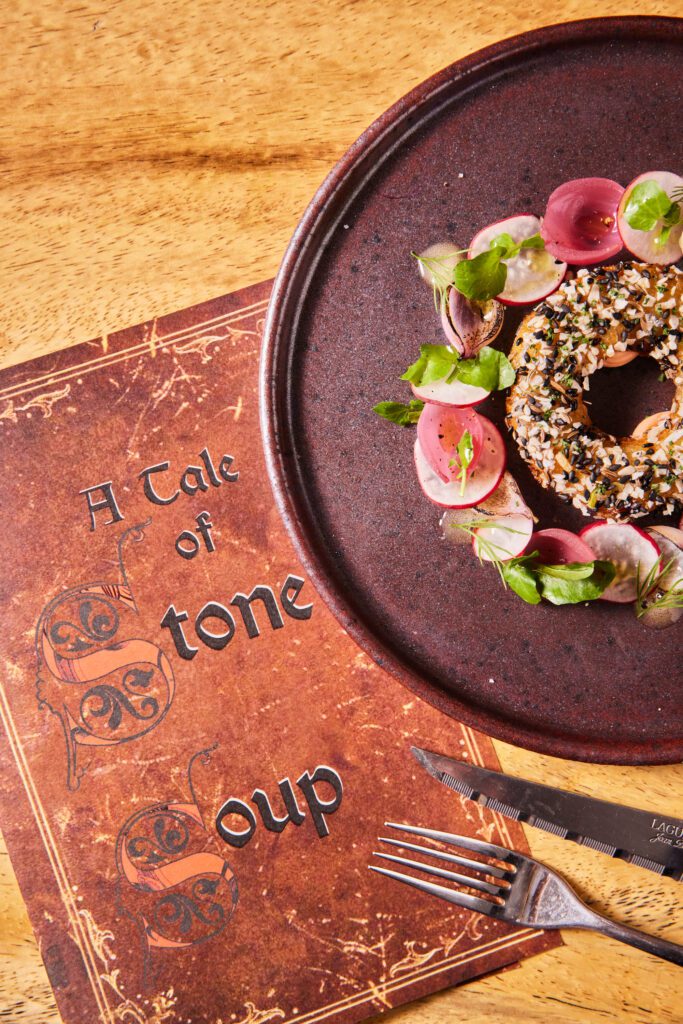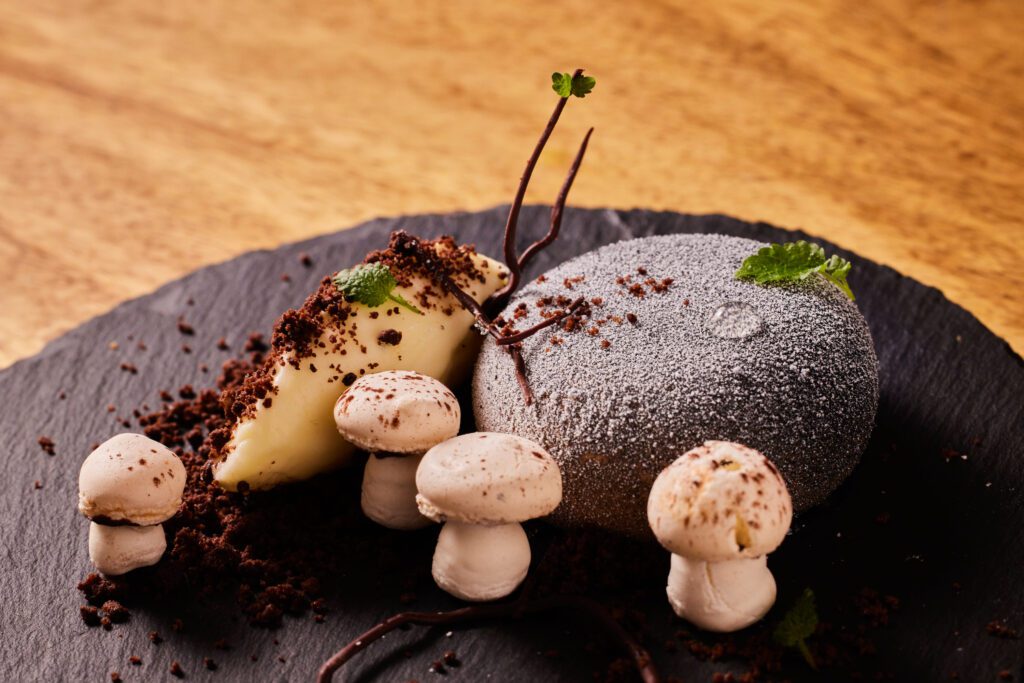Chef-owner Ryan Shelton and his team at Merchant Roots combine style and sustenance with a series of theme-driven, collective dining experiences
Usually when I dine at a Michelin-starred restaurant, I don’t expect to be served a dish that appears to be stones served with water—but look a little closer, and it turns out this amuse-bouche is, somehow, a grilled cheese and smoked tomato broth. It’s a playful start to the latest dining experience at Merchant Roots, an unassuming boutique restaurant tucked into San Francisco’s Fillmore district. Originally founded as an artisan food shop before evolving into a fine dining destination, chef-owner Ryan Shelton restructured the restaurant’s communal dining format in the wake of the pandemic, relaunching as a collective dining experience in October 2021.
The first menu to be served in this new format is the tale of “Stone Soup,” a culinary retelling of the classic European folk story that highlights the moral imperative of sharing. The 9-course culinary sojourn begins in Merchant Roots’ outdoor parklet where diners gather around Chef Shelton. He commences our journey by reading to us the beginning of the tale, in which a group of weary travelers enter a village. Their request for sustenance denied, the travelers go to a nearby stream and fill a pot with water, drop in a large stone, then place it over a fire.

Now, back to the innocuous grilled cheese. What presents as an ashen, vaguely cylindrical stone is pain de mie stuffed with a blend of raclette, parmesan, and gruyère. Its exterior is coated with a concoction of kaolin clay, red cabbage juice, and vegetable charcoal powder which, when toasted, creates a delicate shell that gives the bite its unbelievable appearance. The broth is a clarified tomato water that has been strained through a coffee filter, seasoned with pepper, garlic, and smoked oil that rounds out the bright acidity of the tomato. Representing the beginning of the “Stone Soup” story and menu, it’s a feast for all senses.
The wonder continues with the next course, for which the diners are relocated inside Merchant Roots’ dining room. Like walking into the pages of a leatherbound tome, diners are immersed in a cozy setting that recalls a village of olden times: sheepskin-draped seats with wooden tables that encircle a flickering, indoor-safe fire. (Fun fact: the individual tables were once Merchant Roots’ communal dining table to which Chef Shelton took an axe—a rather symbolic gesture of dining together, yet apart.) Each course focuses on Chef Shelton’s interpretation of a single ingredient, served with an excerpt from the story delivered by the chef and his team. (Merchant Roots has a core group of five culinary artistes behind the recipe design and wine pairings.)

Chef Shelton explains that one curious villager inquires about the “stone soup,” which the group explains is a wonderful broth made from a magic stone. Anticipating a share, the villager donates a few carrots to the cause. The dish that accompanies this chapter is the “Heirloom Carrot Fantasy,” a plate of raw carrot crudo, carrot hummus, and a carrot soda bread topped with a creamy roasted carrot butter. Next, a merchant comes by and provides some of his spices to the “stone soup,” represented by a brioche spice-crusted endive—herbaceous and deeply savory all at once.
The story continues, and series of plates keep coming, including an onion-based course that marries a multitude of flavors. An “everything” bagel composed of beer batter binding with thinly sliced onions tricks the senses with its unusual texture: is it a bagel or is it an onion ring? It’s both. Baked and then fried, finished with a dash of malt vinegar and “everything” spice, the ring sits atop dollops of smoked salmon cream cheese. An onion salad surrounds the ring, a mouthwatering combination of charred and pickled pearl onions, shaved radish, malt vinegar foam, and fresh dill.

The village’s gardener donates aromatic vegetables to the soup, a line in the tale that manifests itself as a miso-glazed rock cod, finished with a pour of shiso lemongrass nage. It’s healing and restorative, especially enjoyed around the fire. As the evening progresses, we move into richer, earthy dishes (but first, a refreshing ginger sorbet palate cleanser). As the villagers in the story continue adding ingredients, such as potatoes, we enjoy an aerated potato beef bourguignon of silky whipped potatoes and red Burgundy-marinated beef short rib with just the perfect amount of caramelization on the edges for a hint of texture. It’s a 3-day process that includes searing, sous vide preparation in tallow followed by a second searing in the tallow for that lovely crisp just before the beef melts in your mouth. A drizzle of herb oil and the tang of horseradish cream cheese cut through the richness.
Next comes a lovely sweet potato soufflé, combining bacon, maple, and pecan. I’m nearly ready to tap out, but then the pièce de résistance (if one must be chosen) begins to arrive. First, a tiny whisk—then, a small beaker of water. A deep bowl with a single “stone” set atop a bed of a curiously snowlike texture completes the mystery, as Chef Shelton begins to lead the diners through the grand finale. We pick up the stone, drop it into the beaker on the count of three, and the stone dissolves—creating an aromatic carrot curry we’re instructed to pour over the snowy bowl. The “snow”—what turns out to be spun sugar—melts away, magically revealing a crisp roasted pork belly underneath. The story culminates with this wondrous dish, which incorporates all the ingredients from the story: “Although the travelers have thus tricked the villagers into sharing their food with them—the magic of the stone may not have transformed water into a delicious soup—it softened the hearts of the cruel town and brought them kindness and conviviality.”

Dessert is yet another miraculous “stone,” this time a pecan-embedded carrot cake enrobed in a shell of speckled cocoa butter and served with ginger ice cream, meringue mushrooms, and a “dirt” crumble of chocolate-sea-salt cookie to complete the tableau. Ribbons of carrot—the “gummy worms”—are braised in ginger and folded into the cookie crumble. Reminiscent of a forest floor, there’s even a dew drop atop the “stone,” which turns out to be mint syrup.
Merchant Roots has successfully transformed its communal dining format to a theme-driven, experiential fine dining destination that can be enjoyed both individually and collectively. The imaginative team of five is passionate about creating a comprehensive meal that integrates entertainment and the element of surprise with exceptional ingredients. It’s not often you visit a restaurant that has you leaving with a rediscovered sense of childlike wonder. It’s fitting, then, that the whimsical theme after “Stone Soup” wraps up in February is “Merchant Roots and the Chocolate Factory.” In the wise words of Willy Wonka himself, “A little nonsense now and then is relished by the wisest men.”
All photos by Hardy Wilson
